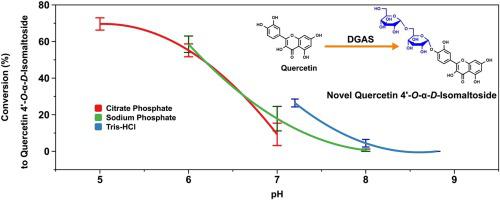当前位置:
X-MOL 学术
›
Enzyme Microb. Technol.
›
论文详情
Our official English website, www.x-mol.net, welcomes your
feedback! (Note: you will need to create a separate account there.)
Amylosucrase from Deinococcus geothermalis can be modulated under different reaction conditions to produce novel quercetin 4′-O-α-D-isomaltoside
Enzyme and Microbial Technology ( IF 3.4 ) Pub Date : 2020-11-01 , DOI: 10.1016/j.enzmictec.2020.109648 Chan-Su Rha , Hyeong Geun Kim , Nam-In Baek , Dae-Ok Kim , Cheon-Seok Park
Enzyme and Microbial Technology ( IF 3.4 ) Pub Date : 2020-11-01 , DOI: 10.1016/j.enzmictec.2020.109648 Chan-Su Rha , Hyeong Geun Kim , Nam-In Baek , Dae-Ok Kim , Cheon-Seok Park

|
Amylosucrase (ASase, EC.4.2.1.4) is well-known for its distinguishable property of transglycosylation of many flavonoids and phenolics. Quercetin has diverse biological functions, however, its use is limited due to poor solubility and bioavailability. ASase derived from Deinococcus geothermalis (DGAS) showed conditional preference for producing unusual quercetin glucosides (QGs). DGAS produced a variety of QGs including quercetin monoglucosides (QG1), diglucosides (QG2 and QG2'), and triglucoside from quercetin and sucrose. The newly synthesized QG2' was recognized as a novel quercetin isomaltoside with an α-1,6 linkage branched at the -OH of C4' in quercetin by mass and nuclear magnetic resonance spectra. With a higher conversion yield from quercetin to QGs (60-92%), the optimum conditions for producing QG2' were examined under various pH and sucrose concentrations by response surface methodology. QG2' was predominantly produced under acidic conditions (pH 5.0) and at high sucrose concentrations (1000-1500 mM). In contrast, QG1 was generated as an intermediate of consecutive glycosylation. Kinetic evaluations indicated that considerable differences of transglycosylation velocities were caused by the pH and buffer salts of the reaction, which had a 3.9-fold higher overall performance (kcat/K'm) of generating QG2' at pH 5 compared to at pH 7. A rationale of unusual transglycosylations was demonstrated with a molecular docking simulation. Taken together, our study demonstrated that ASase can be used to synthesize unusually branched flavonoid glycosides from flavonol aglycones with clear patterns by modulating reaction conditions.
中文翻译:

来自奇异球菌地热的淀粉蔗糖酶可以在不同的反应条件下进行调节,以产生新型槲皮素 4'-O-α-D-异麦芽糖苷
淀粉蔗糖酶(ASase,EC.4.2.1.4)以其可区分的许多类黄酮和酚类物质的转糖基化特性而闻名。槲皮素具有多种生物学功能,但由于溶解性和生物利用度差,其应用受到限制。源自奇异球菌地热 (DGAS) 的 ASase 显示出对生产不寻常的槲皮素糖苷 (QG) 的条件偏好。DGAS 生产多种 QG,包括槲皮素单糖苷 (QG1)、二糖苷(QG2 和 QG2')以及槲皮素和蔗糖的三糖苷。新合成的 QG2' 被认为是一种新的槲皮素异麦芽糖苷,其 α-1,6 键在槲皮素的 C4' 的 -OH 处分支,通过质量和核磁共振光谱。从槲皮素到 QG 的转化率更高 (60-92%),是生产 QG2' 的最佳条件 通过响应面方法在不同的 pH 值和蔗糖浓度下检查。QG2' 主要在酸性条件 (pH 5.0) 和高蔗糖浓度 (1000-1500 mM) 下产生。相比之下,QG1 是作为连续糖基化的中间体产生的。动力学评估表明,转糖基化速度的显着差异是由反应的 pH 值和缓冲盐引起的,与 pH 7 相比,在 pH 5 下生成 QG2' 的总体性能 (kcat/K'm) 高 3.9 倍。通过分子对接模拟证明了异常转糖基化的基本原理。总之,我们的研究表明,ASase 可用于通过调节反应条件从具有清晰模式的黄酮醇苷元合成异常分支的黄酮苷。
更新日期:2020-11-01
中文翻译:

来自奇异球菌地热的淀粉蔗糖酶可以在不同的反应条件下进行调节,以产生新型槲皮素 4'-O-α-D-异麦芽糖苷
淀粉蔗糖酶(ASase,EC.4.2.1.4)以其可区分的许多类黄酮和酚类物质的转糖基化特性而闻名。槲皮素具有多种生物学功能,但由于溶解性和生物利用度差,其应用受到限制。源自奇异球菌地热 (DGAS) 的 ASase 显示出对生产不寻常的槲皮素糖苷 (QG) 的条件偏好。DGAS 生产多种 QG,包括槲皮素单糖苷 (QG1)、二糖苷(QG2 和 QG2')以及槲皮素和蔗糖的三糖苷。新合成的 QG2' 被认为是一种新的槲皮素异麦芽糖苷,其 α-1,6 键在槲皮素的 C4' 的 -OH 处分支,通过质量和核磁共振光谱。从槲皮素到 QG 的转化率更高 (60-92%),是生产 QG2' 的最佳条件 通过响应面方法在不同的 pH 值和蔗糖浓度下检查。QG2' 主要在酸性条件 (pH 5.0) 和高蔗糖浓度 (1000-1500 mM) 下产生。相比之下,QG1 是作为连续糖基化的中间体产生的。动力学评估表明,转糖基化速度的显着差异是由反应的 pH 值和缓冲盐引起的,与 pH 7 相比,在 pH 5 下生成 QG2' 的总体性能 (kcat/K'm) 高 3.9 倍。通过分子对接模拟证明了异常转糖基化的基本原理。总之,我们的研究表明,ASase 可用于通过调节反应条件从具有清晰模式的黄酮醇苷元合成异常分支的黄酮苷。











































 京公网安备 11010802027423号
京公网安备 11010802027423号